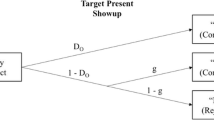Abstract
Reported correlations between accuracy and certainty of eyewitness identifications are sometimes positive, but equally often nil. Examination of theory and research in eyewitness, cognitive, and social psychology suggests that these discrepancies are due to differential instigation of integrative memorial and cognitive processes across eyewitness situations. These processes occur unconsciously and therefore may alter either memory or confidence independently of each other. As a result, accuracy-confidence correspondence should be inversely related to the extensiveness of reconstructive memory processes (which change memory but not confidence) and/or suggestive social influences (which change confidence but not memory). Noncorrespondence is expected when memory is altered by inconsistent information, a criminal stereotype, or a descriptive label of the suspect; or when confidence is altered by factors that promote commitment to testimony or trust in facial memory. It is suggested that police and lawyers avoid behaviors that facilitate these effects and that, along with jurors and possibly even witnesses, they be informed that confidence is often a poor index of accuracy.
Similar content being viewed by others
Reference Notes
Johnson, C., & Scott, B.Eyewitness testimony and suspect identification as a function of arousal, sex of witness, and scheduling of interrogation. Paper presented at the annual convention of the American Psychological Association, Washington, D.C., 1976.
References
Bem, D. J., Self-perception theory. In L. Berkowitz (Ed.).Advances in experimental social psychology, Vol. 6. New York: Academic Press, 1972.
Bem, D. J. Psychology and society. In E. R. Hilgard, R. L., Atkinson, & R. C. Atkinson,Introduction to psychology, 7th edition. New York: Harcourt, Brace, Jovanovich, 1979.
Bower, G. H. A multicomponent theory of the memory trace. In K. W. Spence & J. T. Spence (Eds.),The psychology of learning and motivation: Advances in theory and research, Vol. 1., New York: Academic Press, 1967.
Brehm, J. W., & Cohen, A. R.,Explorations in cognitive dissonance. New York: Wiley, 1962.
Chance, J., & Goldstein, A. G. Recognition of faces and verbal labels.Bulletin of the Psychonomic Society, 1976,7, 384–387.
Clifford, B. R., & Bull, R.The psychology of person identification. London: Routledge & Kegan Paul, 1978.
Deffenbacher, K. A. Eywitness accuracy and confidence: Can we infer anything about their relationship? This issue,Law and Human Behavior, 1980,4, 243–260.
Doob, A. N., & Kirshenbaum, H. M. Bias in police lineups—Partial remembering.Journal of Police Science and Administration, 1973,1, 287–293.
Franks, J. J., & Bransford, J. D. Abstraction of visual patterns.Journal of Experimental Psychology, 1971,90, 65–74.
Kiesler, C. A. (Ed.)The psychology of commitment: Experiments linking behavior to belief. New York: Academic Press, 1971.
Leippe, M. R., Wells, G. L. & Ostrom, T. M. Crime seriousness as a determinant of accuracy in eyewitness identification.Journal of Applied Psychology, 1978,63, 345–351.
Loftus, E. F., & Loftus, G. R. On the permanence of stored information in the human brain.American Psychologist, 1980,35, 409–420.
Loftus, E. F., Miller, D. G., & Burns, H. J. Semantic integration of verbal information into a visual memory.Journal of Experimental Psychology: Human Learning and Memory, 1978,4, 19–31.
Loftus, G. R. Eye fixations and recognition memory.Cognitive Psychology, 1972,3, 525–557.
Malpass, R. S., & Devine, P. G. Eyewitness identification: Lineup instructions and the absence of the offender.Journal of Applied Psychology (in press).
Morris, P. Encoding and retrieval. In M. M. Gruneberg & P. Morris (Eds.),Aspects of memory. London: Methuen, 1978.
Murdock, B. B., Jr.Human memory: Theory and data. Hillsdale, New Jersey: Erlbaum, 1974.
Neil vs. Biggers. 409 U.S. 188 (1972).
Neisser, U.Cognitive psychology. New York: Appleton-Century-Crofts, 1967.
Nisbett, R. E., & Wilson, T. D. Telling more than we can know: Verbal, reports on mental processes.Psychological Review, 1977,84, 231–259.
Shoemaker, D. J., South, D. R., & Lowe, J. Facial stereotypes of deviants and judgments of guilt or innocence.Social Forces, 1973,51, 427–433.
Tesser, A. Self-generated attitude change. In L. Berkowitz (Ed.),Advances in experimental social psychology, Vol. 11. New York: Academic Press, 1978.
Tesser, A., & Leone, C. Cognitive schemas and thought as determinants of attitude change.Journal of Experimental Social Psychology, 1977,13, 340–356.
Wells, G. L. Applied eyewitness-testimony research: System variables and estimator variables.Journal of Personality and Social Psychology, 1978,36, 1546–1557.
Wells, G. L., Leippe, M. R., & Ostrom, T. M. Guidelines for empirically assessing the fairness of a lineup.Law and Human Behavior, 1979,3, 285–293.
Wells, G. L., Lindsay, R. C. L., & Ferguson, T. J. Accuracy, confidence, and juror perceptions in eyewitness identification.Journal of Applied Psychology, 1979,64, 440–448.
Wickelgren, W. A. Multitrace strength theory. In D. A. Norman (Ed.),Models of human memory. New York: Academic Press, 1970.
Author information
Authors and Affiliations
About this article
Cite this article
Leippe, M.R. Effects of integrative memorial and cognitive processes on the correspondence of eyewitness accuracy and confidence. Law Hum Behav 4, 261–274 (1980). https://doi.org/10.1007/BF01040618
Issue Date:
DOI: https://doi.org/10.1007/BF01040618




